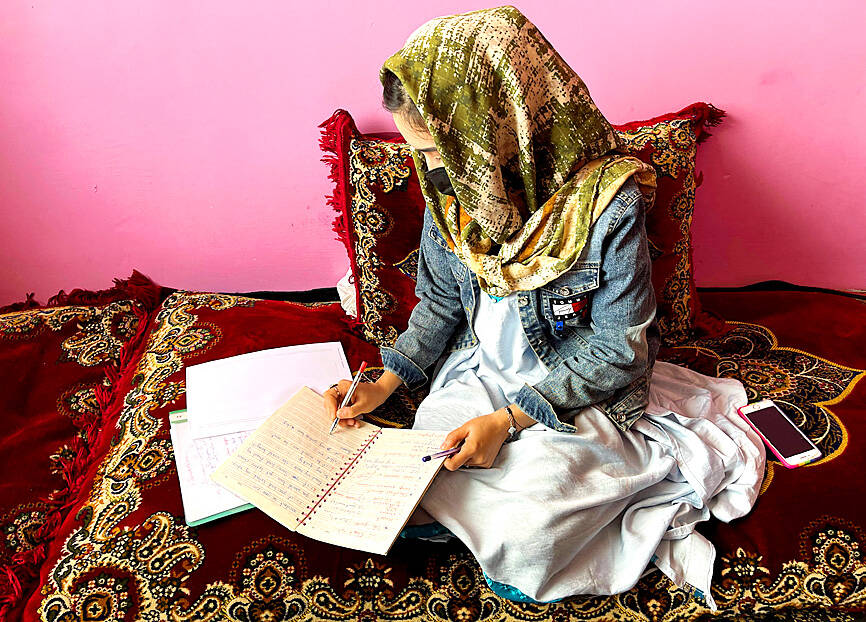Sofia logged in to class on a laptop in Kabul for an online English course run by one of a growing number of educational institutes trying to reach Afghanistan’s girls and women digitally in their homes.
However, when the teacher called on Sofia to read a passage, her computer screen froze.
“Can you hear me?” she asked repeatedly, checking her connection.

Photo: Reuters
After a while, her computer stuttered back to life.
“As usual,” a fellow student equally frustrated with the poor communications said as the class resumed.
Sofia, 22, is one of a growing stream of Afghan girls and women going online as a last resort to get around the Taliban administration’s restrictions on studying and working.
Taliban officials, citing what they call problems including issues related to Islamic dress, have closed girls’ high schools, barred their access to universities and stopped most women from working at non-governmental organizations.
One of the most striking changes since the Taliban were first in power, from 1996 to 2001, is the explosion of the Internet.
Virtually no one had access to the Internet when the Taliban were forced from power in the weeks after the attacks on the US on Sept. 11, 2001.
After nearly two decades of Western-led intervention and engagement with the world, 18 percent of the population had Internet access, World Bank data showed.
The Taliban has allowed girls to study individually at home and has not moved to ban the Internet, which its officials use to make announcements via social media.
However, girls and women face a host of problems, from power cuts to cripplingly slow Internet speeds, let alone the cost of computers and Wi-Fi, in a country where 97 percent of people live in poverty.
“For girls in Afghanistan, we have a bad, awful Internet problem,” Sofia said.
Her online school, Rumi Academy, saw its enrollment of mostly females rise from about 50 students to more than 500 after the Taliban took over in 2021.
It has had hundreds more applications, but cannot enroll them for now because of a lack of funds for teachers and to pay for equipment and Internet packages, a representative of the academy said.
Sakina Nazari tried a virtual language class at her home in Kabul for a week after she was forced to leave her university in December, but she abandoned it in frustration after battling the problems.
“I couldn’t continue,” she said. “It’s too hard to access Internet in Afghanistan, and sometimes we have half an hour of power in 24 hours.”
Some Afghans have started calling on SpaceX CEO Elon Musk to introduce its satellite Internet service Starlink to Afghanistan, as it has done in Ukraine and Iran, posting requests for help on Twitter.
“We also call on Elon Musk to help us,” Sofia said. “If they would be able to [introduce] that in Afghanistan, it would be very, very impactful for women.”
Online schools are trying to accommodate Afghanistan’s pupils.
Daniel Kalmanson, spokesperson for the online University of the People, which has had more than 15,000 applications from Afghan girls and women since the Taliban took over, said students can attend lectures at any time that conditions allow, and professors grant extensions on assignments when students face connection problems.
The non-profit Learn Afghanistan group, which runs several community-based schools with some remote classes, makes its curriculum available for free in Afghanistan’s main languages.
Executive director Pashtana Durrani said the group makes lessons available via radio and works with international companies to find solutions to poor Internet access.
“Afghanistan needs to be a country where the Internet is accessible, digital devices need to be pumped in,” Durrani said.
Sofia said that Afghan women had grown used to problems over years of war and they know how to persevere.
“We still have dreams and we will not give up, ever,” she said.

In the sweltering streets of Jakarta, buskers carry towering, hollow puppets and pass around a bucket for donations. Now, they fear becoming outlaws. City authorities said they would crack down on use of the sacred ondel-ondel puppets, which can stand as tall as a truck, and they are drafting legislation to remove what they view as a street nuisance. Performances featuring the puppets — originally used by Jakarta’s Betawi people to ward off evil spirits — would be allowed only at set events. The ban could leave many ondel-ondel buskers in Jakarta jobless. “I am confused and anxious. I fear getting raided or even

Kemal Ozdemir looked up at the bare peaks of Mount Cilo in Turkey’s Kurdish majority southeast. “There were glaciers 10 years ago,” he recalled under a cloudless sky. A mountain guide for 15 years, Ozdemir then turned toward the torrent carrying dozens of blocks of ice below a slope covered with grass and rocks — a sign of glacier loss being exacerbated by global warming. “You can see that there are quite a few pieces of glacier in the water right now ... the reason why the waterfalls flow lushly actually shows us how fast the ice is melting,” he said.

Eleven people, including a former minister, were arrested in Serbia on Friday over a train station disaster in which 16 people died. The concrete canopy of the newly renovated station in the northern city of Novi Sad collapsed on Nov. 1, 2024 in a disaster widely blamed on corruption and poor oversight. It sparked a wave of student-led protests and led to the resignation of then-Serbian prime minister Milos Vucevic and the fall of his government. The public prosecutor’s office in Novi Sad opened an investigation into the accident and deaths. In February, the public prosecutor’s office for organized crime opened another probe into

RISING RACISM: A Japanese group called on China to assure safety in the country, while the Chinese embassy in Tokyo urged action against a ‘surge in xenophobia’ A Japanese woman living in China was attacked and injured by a man in a subway station in Suzhou, China, Japanese media said, hours after two Chinese men were seriously injured in violence in Tokyo. The attacks on Thursday raised concern about xenophobic sentiment in China and Japan that have been blamed for assaults in both countries. It was the third attack involving Japanese living in China since last year. In the two previous cases in China, Chinese authorities have insisted they were isolated incidents. Japanese broadcaster NHK did not identify the woman injured in Suzhou by name, but, citing the Japanese